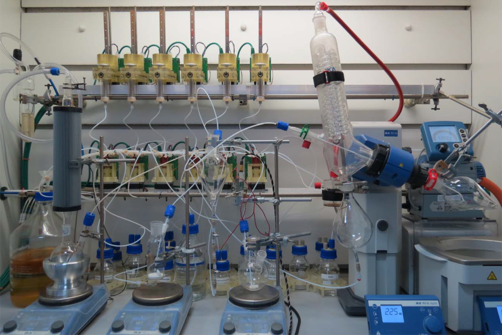Division Structure Analysis is currently seeking a student (f/m/d) for the project "Synthesis of metal-organic framework precursors using an automated discovery platform"
Metal-organic frameworks (MOFs) have been a popular research target for a few decades now due to high potential applicability in catalysis, gas sorbtion and separation and other applications. One of the most popular classes of MOFs are metal carboxylates. These MOFs often, although not always, contain a di-carboxylic acid with an approximately linear molecular geometry (the simplest one is terephthalic acid) that links metal cations in octahedral coordination geometry. Aside from terephthalic acid other di-carboxylic acids required for synthesis can be very expensive and therefore the research with these materials is often performed on a small scale. However, the precursors to these acids are generally much more readily available and the conversion to the required di-carboxylic acids can be accomplished with few simple chemical manipulations. Unfortunately, these often require use of air sensitive and somewhat dangerous reagents and therefore are seldom performed outside dedicated synthesis laboratories. Development of an automated synthesis platform capable of performing these transformations automatically would allow the access to these, often expensive, chemicals safely and rapidly to research groups that do not specialize in total synthesis, yet do have an automated synthesis platform like “Chemputer”.
In this project 4,4’-biphenyl-dicarboxylic acid (relatively expensive commercially) would be synthesized from 4,4-dibromobiphenyl (comparably cheap) using air sensitive reagents (nBuLi) and develop and implement methodology of performing air and water free chemical reactions on multi-gram scale using “Chemputer”. If successful the product would be used in MOF synthesis in other projects. “Chemputer” device was specifically developed for chemical synthesis, yet air-free conditions are rarely used. Successful implementation would not only make different reactions more consistently air-free between different batches compared to conventional synthesis but also safer, considering the nature of some air-sensitive reagents (such as BuLi, Me3Al, Et2Zn and others).
The success of the reactions would be evaluated using low-field NMR linked to the “Chemputer”. Auxiliary analysis methods like XRD and IR will also be employed. During the project an air free general synthesis and evaluation method would be developed and automated. The system would automatically perform reagent sequential mixing, temperature control, workup and product analysis.

The “chemputer”
Source: BAM, Structure Analysis Division
Project duration: to be agreed, typically 2-6 months depending if it is a BSc or MSc, but can be extended
Requirements
- Studies in Chemistry or associated subject with a significant experimental component.
- At least basic Python skills are essential. Intermediate or Advanced Python is preferred;
- Proficiency in English is NOT required.
Contact
CV and a letter of motivation to tomasz.stawski@bam.de; Either in DE or EN.
Dr. Tomasz Stawski
Division Structure Analysis
Phone: +49 330 8104 3395
Email: tomasz.stawski@bam.de


